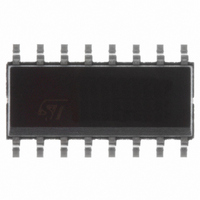L6566B STMicroelectronics, L6566B Datasheet - Page 26

L6566B
Manufacturer Part Number
L6566B
Description
IC CTRLR OVP OTP UVLO HV 16SOIC
Manufacturer
STMicroelectronics
Datasheet
1.L6566BTR.pdf
(51 pages)
Specifications of L6566B
Output Isolation
Isolated
Frequency Range
10 ~ 300kHz
Voltage - Input
8 ~ 23 V
Power (watts)
750mW
Operating Temperature
-40°C ~ 150°C
Package / Case
16-SOIC (0.154", 3.90mm Width)
Output Current
800 mA
Output Power
750 mW
Input Voltage
8 V to 23 V
Operating Temperature Range
- 40 C to + 150 C
Mounting Style
SMD/SMT
Duty Cycle (max)
75 %
Selectable Multi-mode Operation
fixed frequency or quasi-resonant
For Use With
497-6452 - BOARD EVAL FOR L6566B497-6451 - BOARD EVAL FOR L6566B497-6450 - BOARD EVAL FOR L6566B497-6449 - BOARD EVAL FOR L6566A
Lead Free Status / RoHS Status
Lead free / RoHS Compliant
Available stocks
Company
Part Number
Manufacturer
Quantity
Price
Part Number:
L6566B
Manufacturer:
ST
Quantity:
20 000
Part Number:
L6566BHTR
Manufacturer:
ST
Quantity:
20 000
Part Number:
L6566BTR-13
Manufacturer:
ST
Quantity:
20 000
Application information
5.5
26/51
PWM control block
The device is specific for secondary feedback. Typically, there is a TL431 on the secondary
side and an optocoupler that transfers output voltage information to the PWM control on the
primary side, crossing the isolation barrier. The PWM control input (pin 9, COMP) is driven
directly by the phototransistor’s collector (the emitter is grounded to GND) to modulate the
duty cycle (
In applications where a tight output regulation is not required, it is possible to use a primary-
sensing feedback technique. In this approach the voltage generated by the self-supply
winding is sensed and regulated. This solution, shown in
is cheaper because no optocoupler or secondary reference is needed, but output voltage
regulation, especially as a result of load changes, is quite poor.
Figure 14. Possible feedback configurations that can be used with the L6566B
Ideally, the voltage generated by the self-supply winding and the output voltage should be
related by the Naux/Ns turn ratio only. Actually, numerous non-idealities, mainly
transformer's parasites, cause the actual ratio to deviate from the ideal one. Line regulation
is quite good, in the range of ± 2 %, whereas load regulation is about ± 5 % and output
voltage tolerance is in the range of ± 10 %.
The dynamics of the pin is in the 2.5 to 5 V range. The voltage at the pin is clamped
downwards at about 2 V. If the clamp is externally overridden and the voltage on the pin is
pulled below 1.4 V the L6566B will shut down. This condition is latched as long as the
device is supplied. While the device is disabled, however, no energy is coming from the self-
supply circuit, thus the voltage on the Vcc capacitor will decay and cross the UVLO
threshold after some time, which clears the latch and lets the HV generator restart. This
function is intended for an externally controlled burst-mode operation at light load with a
reduced output voltage, a technique typically used in multi-output SMPS, such as those for
TVs or monitors (see the timing diagram
L6566B
Secondary feedback
Figure 14
9
COMP
TL431
, left-hand side circuit).
Vout
Figure 15 on page 27
COMP
L6566B
9
Figure 14
Primary feedback
5
).
Vcc
, right-hand side circuit,
Cs
L6566B
N
aux













